Venus

Venus |

|
|
| Home | Stars | Orbits | Habitability | Life | | |||
| | System Summary | Rocky Inner Planets | Main Asteroid Belt | Gas Giants | E-K Belt & Dust Disk | Oort Cloud | | |||
| | Sol | Mercury | Venus | Earth | Mars | Jupiter | Saturn | Uranus | Neptune | Dwarf Planets | Sol b? | |
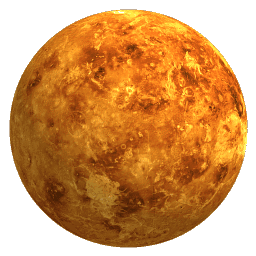
NASA (radar image)
Breaking News
On October 6, 2011, scientists using the the European Space Agency's Venus Express mission have detected a thin, tenuous layer of ozone high in the planet's atmosphere like Earth and Mars, in addition to the high layer of sulfur dioxide detected in 2010. A molecule containing three oxygen atoms, computer models suggest that ozone on Venus is formed when sunlight breaks up carbon dioxide molecules and releases oxygen atoms, which are swept around to the planet's nightside by winds where they can then combine to form unstable, three-atom ozone molecules, as well as much more stable, two-atom molecules essential for animals. Earth's much thicker layer of low-level ozone, however, has a much larger contribution from the build-up of molecular oxygen beginning some 2.4 billion years ago from photosynthetic microbes excreting oxygen as a waste gas, which now along with plant life is constantly replenishing Earth's two-atom as well as three-stom ozone oxygen molecules. The presence of ozone helps to explain the detection of hydroxyl (an unstable molecule of oxygen with a single atom of hydrogen) high in planet's atmosphere in 2008 (ESA news releases on ozone, sulfur dioxide, and hydroxyl; Lisa Grossman, New Scientist, October 6, 2011; and Montmessin et al, 2011).
 AOES Medialab,
ESA
AOES Medialab,
ESA
Alternative, larger and
jumbo
illustrations of hydroxyl in Venus'
nightside by ESA and C. Carreau.
A tenuous, thin layer of ozone
has been detected high in Venus'
atmosphere that probably forms
in its nightside
(more).
The Planet
The second planet from the Sun at about seven tenths of the Earth-Sun distance, Venus is the sixth largest planet but has no moon. It has the most circular orbit of all the planets in the Solar System, with an eccentricity of less than one percent. (See an animation of Venus' orbit around the Sun, with a table of basic orbital and physical characteristics.) However, its rotation is very slow with 243 Earth days in a single "Venus day," which is slightly longer than the planet's year, and retrograde when compared with Earth's so that the Sun rises in the west and sets in the east. The planet's period of rotation is synchronized with its orbital period so that Earth always sees the same face when Venus is at its closest approach. On the other hand, Venus can be seen from Earth with the naked eye as the brightest "star" in the night sky.
At a meeting of the American Astronomical Society on October 9, 2006, two planetary scientists (Alex Alemi and David Stevenson) described model results which suggest that Venus may have once had a moon that was subsequently destroyed. Under current theories of solar system formation, Venus is unlikely to have avoided a protoplanetary collision large enough to create a moon, and computer simulations suggest that most large collisions create a debris disk from which a moon forms. Alemi and Stevenson suggest that a sequence of two large collisions within around 10 million years could have first created a moon but then destroyed it and sent debris crashing onto Venus; this eventually created the planet's slow retrograde rotation today, which is otherwise difficult to explain (Alemi and Stevenson, 2006; and George Musser, Scientific American Science News, October 10, 2006).
The planet was once thought to be a near twin of Earth because of its similar size, being only slightly smaller with 95 percent of Earth's diameter at 12,103 kilometers (7,522 miles) and 80 percent of its mass. The densities and chemical compositions of the two rocky planets are also similar, and radar observations found that Venus has relatively few craters indicating a relatively young or quickly changing surface like Earth. As a result, it was thought that below the planet's dense clouds, Venus might even have life. However, more recent investigations have found quite the opposite.
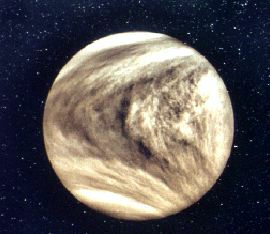 The planet is covered with thick white and yellowish clouds made of
sulfuric acid droplets, instead of water. There are strong winds of
350 kilometers per hour (218 miles per hour) at the cloud tops, but
surface winds are weak -- no more than a few kilometers (or miles) per
hour. Venus has no oceans and is surrounded by a heavy atmosphere
composed mostly of carbon dioxide.
The planet is covered with thick white and yellowish clouds made of
sulfuric acid droplets, instead of water. There are strong winds of
350 kilometers per hour (218 miles per hour) at the cloud tops, but
surface winds are weak -- no more than a few kilometers (or miles) per
hour. Venus has no oceans and is surrounded by a heavy atmosphere
composed mostly of carbon dioxide.
NASA (ultraviolet image) --
another image
The atmospheric pressure at the surface is equivalent to 92 atmospheres,
which is like the pressure found one kilometer (0.62 miles) down
Earth's oceans.
This dense atmosphere generated a runaway greenhouse effect that has raised the planet's surface temperature by about 400 degrees Celsius to about 467° C (862 °F), which is hot enough to melt lead. Sunlight passes through the atmosphere to heat the surface of the planet, but this solar heat is trapped by the dense atmosphere instead of radiating back out to space as efficiently as it does on Earth. As a result, Venus' surface is actually hotter than Mercury's despite being nearly twice as far from the Sun.
 Venus
Express,
ESA
Venus
Express,
ESA
Larger composite images,
dayside at left and nightside
at right.
A vortex cloud structure has
been found at the south pole,
mirroring a similar structure
at the north pole
(more).
On September 23, 2010, scientists using the the European Space Agency's Venus Express mission released infrared images of a single storm vortex at the planet's South Pole, although a double vortex was apparently detected both by NASA's Pioneer Venus Mission in 1979 and the ESA's Venus Express mission in 2006. The single vortex extends over 3,000 kilometers (1,900 miles) in diameter, and recently released videos (including A and B) of the vortex suggest similarities with a vortex over Saturn's South Pole. More observations may confirm whether a double vortex does sometimes develop over time (Europlanet press release with more images and animations; and Astronomy Picture of the Day).
 Venus
Express,
INAF-IASF,
Venus
Express,
INAF-IASF,
Observatoire de Paris-LESIA,
VIRTIS,
Venus Express,
ESA
Larger composite, infrared
image.
The storm at Venus' South
Pole was recently imaged
as a single vortex, although
a double vortex had been
previously detected
(more).
On July 19, 2009, Frank Melillo, an amateur astronomer, spotted a large bright spot in the clouds of Venus, which was soon confirmed by the European Space Agency's Venus Express mission. Review of mission data indicated that the spreading spot appeared at least four days before on July 15th. This is not the first sighting of a bright patch in the Venusian atmosphere, but scientists are not certain whether the new spot is the result of a volcanic eruption, interactions with the charged particles of the Solar Wind, or a concentration of bright substances caused by atmospheric turbulence (more from Paul Sutherland, Skymania.com, July 21, 2009; Rachel Courtland, New Scientist, July 29, 2009; Andrea Thompson, Live Science, July 30, 2009; and BBC News, August 1, 2009).
 Venus
Express,
MPS,
ESA
Venus
Express,
MPS,
ESA
Ultraviolet image
montage.
A bright spot in the
clouds of Venus was
recently spotted
(more).
During initial orbit capture on March 12, 2006, the European Space Agency's Venus Express spacecraft took photos of sunlight reflected from the tops of clouds down to a height of about 65 kilometers (40.4 miles) above the planet’s surface which revealed a vortex cloud structure at the south pole, mirroring previous findings at the north pole (more). On September 18, 2008, the ESA mission released an image, animation, and illustration discussing the different atmospheric layers and respective wind speeds between the equator and from 50 to 55 degrees latitude on the planet's southern hemisphere, as measured between April 2006 and June 2007. Using three different visual and infrared wavelengths to observe three different atmospheric layers, Venus Express tracked the movement of clouds and determined the speed of the winds moving them. Faster winds were observed above the sulfuric acid clouds and haze layers, rather than below (more discussion).
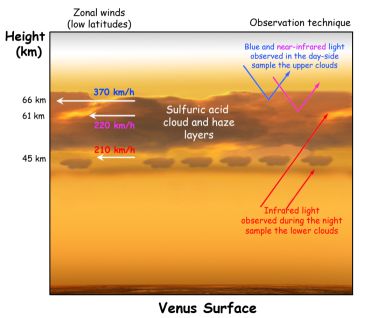
Venus
Express,
ESA
Larger illustration.
Winds above the sulfuric acid
clouds and haze are faster than
those observed below
(more).
On February 21, 2008, the European Space Agency's Venus Express released ultraviolet images that reveal the planet to have large-scale weather changes. Rich in sulfuric acid, bright hazes appear in a matter of days, reaching from the planet's south pole to its low southern latitudes, and disappear just as quickly. Such hazes are created when water vapor is lifted by an unknown process with sulfur dioxide from lower levels into the planet' upper atmosphere, where it is broken down by sunlight into molecules that recombine into volatile sulfuric acid. Under ultraviolet light examination, transient dark and bright stripes mark Venus' atmosphere, indicating regions where Solar ultraviolet radiation is either absorbed or reflected, respectively (more from Venus Express and APOD).
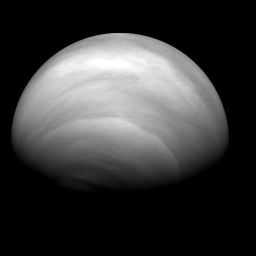 Venus
Express,
Venus
Express,
MPS/DLR/IDA,
ESA
Larger ultraviolet image.
Venus has large-scale weather
changes with bright, high-
altitude hazes that appear in
a matter of days, and disappear
just as quickly
(more).
Venus probably once had large amounts of water like Earth, but the planet is now quite dry. Its oceans probably boiled away into its atmosphere as its runaway greenhouse effect progressed. This may have occurred because Venus is closer than Earth to the Sun, which has also grown about 40 percent brighter over the past 4.6 billion years. One recent theory suggests that Earth may suffer the same fate within 900 million years as Sol continues to brighten by about 10 percent.
 C. Carreau,
ASPERA-4
& MAG teams,
C. Carreau,
ASPERA-4
& MAG teams,
Venus
Express,
ESA
Annotated image illustrating loss
of hydrogen through plasma wake
Venus may have lost oceans of water
due to a runaway greenhouse effect
which evaporated water into the upper
atmosphere, where ultraviolet light
dissociated water into ionized atomic
hydrogen and oxygen (some later
incorporated into carbon dioxide)
that were blown away by the Solar
wind due to the lack of a strong
magnetic field like the Earth's
(more).
On November 28, 2007, the Venus Express mission released images and illustrations describing the "true extent" and processes by which the Sun has been stripping away the planet's atmosphere, including oceans of water over the past five billion years (ESA news release -- more discussion below). Venus is not protected by a strong magnetic field like Earth, and so its upper atmosphere probably has been much more affected by the Sun's Solar wind, which blows away relatively light, hydrogen, helium, and oxygen atoms much faster than happens in Earth's atmosphere. As a result, once water molecules are dissociated into ionized hydrogen and oxygen atoms by the Sun's ultraviolet light in Venus' upper atomsphere, they are more easily blown into space by the Solar wind (S.I. Rasool, 1968). Although many scientists believe that Venus may once have had oceans of water on its surface (in part because its ratio of deuterium to ordinary hydrogen is now measured to be around 150 times that of the Earth's), most of it has been lost the past five billion years. (More discussion on the processes believed to be driving the evolution of Venus' atmosphere from Professor Nick Strobel).

Courtesy of the Vernadsky Institute, Moscow --
smaller, high-contrast image
(Additional image processing by
Carlé
Pieters and colleagues at Brown University,
assembled for
Astronomy: The Cosmic
Journey by William K.
Hartmann and
Chris
Impey)
Around the
Venera 13
probe at bottom, the dissicated, daytime landscape of Venus displays
a yellowish-orange hue under a cloudy yellowish-white sky and the
natural, mustard-colored
light filtering through the planet's thick atmosphere
Around 1988, Jeffrey Kargel of the US Geological Survey estimated that Venus may have lost its water around four billion years ago -- just 600 million years after the Solar System's birth. In 2003, David Grinspoon of the Southwest Research Institute in Boulder, Colorado suggested, however, that water may have persisted for another two billion years. Kargel's estimate should be considered to be a lower limit on when the planet dried up because it did not include the effect of clouds in the Venusian atmosphere. The clouds would have reflected sunlight back into space to cool the Venusian surface, so that its atmosphere would have been 100 Kelvin cooler than without them.

Soviet Academy of Sciences (U.S.S.R) and
NASA
-- larger image
Wider view of rocks around the base of the
Venera 13
probe,
which survived for only 127 minutes on Venus' surface.
On July 14, 2009, the European Space Agency's Venus Express released infrared mapping data of the planet's southern hemisphere, which suggest that Earth's neighbor once produced large masses of granitic rock. On Earth, plate tectonics forces basaltic rock deep closer to the hot mantle until melting and mixing with water forms lighter granitic rock that eventually rises to the surface through volcanic activity to form continental crust (more). As rocks on Venus' Phoebe Regio and Alpha Regio plateaus are slightly cooler and lighter in color, they appear older than those found in most of the rest of the planetary surface and so may be ancient continents that were created by volcanoes in an ancient ocean. (The ESA spacecraft arrived at Sol's hottest planet on March 11, 2006, where it is being used to investigate how Venus -- although similar to Earth in size, mass, and composition -- evolved over the past 4.6 billion years to have atmospheric and planetary surface characteristics that now appear very different from those on Earth.)
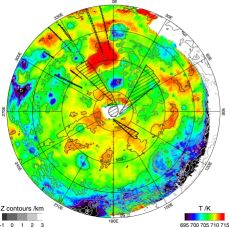 Venus
Express,
Venus
Express,
VIRTIS,
INAF-IASF,
Obs. de Paris-LESIA,
ESA
Larger infrared image.
Cooler (bluer) plateaus in
Venus' southern atmosphere
may be composed of older
rocks produced by plate
tectonics with volcanoes
in an ancient ocean
(more).
Most of Venus' surface consists of gently rolling plains with little relief. There are several broad depressions and two large highland areas, one in the northern hemisphere about the size of Australia and one along the equator about the size of South America. Radar observations find that about 80 percent of the surface is covered by lava flows with a few Australia-size uplands of two to five km (1.2 to 3.1 miles) high, and there are large shield volcanoes that rise above the plains as high as 11 km (6.8 miles) -- higher than Mount Everest's eight km (five miles) above Earth sea-level.
 Magellan,
JPL,
NASA
Magellan,
JPL,
NASA
Larger radar image.
Lava flows in the
Western
Eistla Regio
extend for hundreds of kilometers
across fractured plains to the base
of Gula Mons, a three-km (1.86-mile)
high volcano (upper left), and to
two-km (1.2-mile) high volcano Sif
Mons (upper right), which has a
diameter of 300 km (180 miles).
Venus may still volcanically active in a few hot spots, but in general,
it has been geologically quiet for the past few hundred million years.
The oldest surface features seem to be about 800 million years old,
but extensive volcanism about 300 to 500 million years ago appears to
have wiped out earlier surfaces including large craters from the
planet's early history. There are no small craters because small
meteoroids burn up in the dense atmosphere before reaching the ground,
and the bunching of craters suggest that large meteoroids usually break
up before reach the surface.

Courtesy Jet Propulsion Laboratory. Copyright (c) California
Institute of Technology, Pasadena, CA. All rights reserved.
Around 700 million years ago, the entire Venusian surface appears to have melted and reformed, which may have been a continuation of the greenhouse warming that dried out the planet. According to David Grinspoon, once Venus lost its water, plate tectonics would have stopped and so the planet would lost the most efficient way for it shed its internal heat. Eventually, the heat built up under the crust until it reached melting temperatures, allowing heat to be more quickly radiated into space.
On April 8, 2010, the European Space Agency's Venus Express mission has detected relatively recent lava flows around what appear to be nine volcanoes on the surface of Venus. The lava flows appear to have different compositions from surrounding terrain which appear to be due to a lack of surface weathering. This finding suggests that the flows erupted relatively recently, within 2.5 million years ago or even more recently. It is possible that the volcanoes are currently active (ESA new release; and Dennis Overbye, New York Times, April 9, 2010).
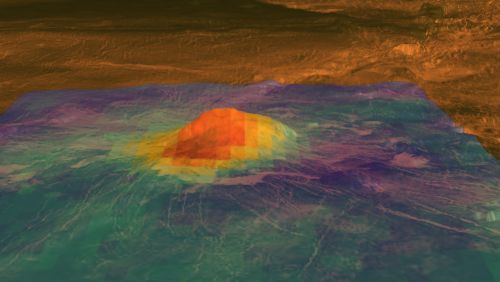 Venus
Express,
ESA,
Venus
Express,
ESA,
JPL,
NASA
Larger thermal and radar,
composite
image of
volcanic peak
Idunn Mons.
Relatively fresh lava has
been detected around nine
volcanoes on Venus
(more).
The interior of Venus is probably very similar to that of Earth, with an iron core about 6,000 km (3,700 miles) in diameter radius and a molten rocky mantle comprising most of the planet. Gravity data indicate that its crust is strong and thick. Convection in the mantle stresses the surface like the Earth but is relieved in many relatively small regions instead of being concentrated at plate boundaries as happens on Earth. Venus has no magnetic field, perhaps because of its slow rotation.
(Discussion moved here.)
Other Information
More images and information on Venus are available from NASA's Magellan Mission to Venus web site at the Jet Propulsion Laboratory, and from NASA's Planetary Photojournal. A fact sheet on Venus is also available from NASA's National Space Science Data Center.
David Seal (a mission planner and engineer at NASA's Jet Propulsion Laboratory at CalTech) has a web site that generates simulated images of the Sun, planets, and major moons from different perspectives and at different times of the year. Try his Solar System Simulator.
For more information about the Solar System, go to William A. Arnett's website on "The Nine Planets", or to Calvin J. Hamilton's web page on "Venus".
© 1998-2011 Sol Company. All Rights Reserved. |